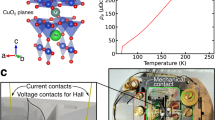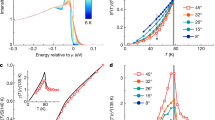Abstract
THE magnetic field penetration depth λ is a basic parameter of superconductivity, related to ns/m* (superconducting carrier density/effective mass) as λ-2 ∝ ns/m* in the limit where the coherence length ζ is much shorter than the mean free path l (the 'clean limit'). Muon spin relaxation (µSR) measurements1,2 of λ in high-transition-temperature (high-Tc ) copper oxide superconductors have revealed remarkable correlations between Tc and ns/m*: Tc increases linearly with ns/m* in the underdoped region, followed by a saturation with increasing carrier doping. Here we report µSR measurements of λ in ceramic specimens of of the superconductor TI-2Ba2CuO6+δ (TI-2201) in the 'overdoped' region where Tc decreases with increasing hole doping. Recent measurements of upper critical field and resistivity3confirm that overdoped TI-2201 lies well in the clean limit with a ζ<<l. We find that the muon spin relaxation rate σ(T → 0) ∝ λ −2 ∝ ns/m* in TI-2201 decreases with increasing hole doping, implying that either ns no longer scales with the normal-state carrier density nn , and/or m* for a superconducting pair becomes much larger than the value expected from the normal-state effective mass m*n . This behaviour of overdoped TI-2201 is in marked contrast to conventional metallic superconductors having a retarded interaction, in which the normal-state properties (nn , m*n , l)directly represent the corresponding values in the superconducting state.
This is a preview of subscription content, access via your institution
Access options
Subscribe to this journal
Receive 51 print issues and online access
$199.00 per year
only $3.90 per issue
Buy this article
- Purchase on Springer Link
- Instant access to full article PDF
Prices may be subject to local taxes which are calculated during checkout
Similar content being viewed by others
References
Uemura, Y. J. et al. Phys. Rev. Lett. 62, 2317–2320 (1989).
Uemura, Y. J. et al. Phys. Rev. Lett. 66, 2665–2668 (1991).
Mackenzie, A. P. et al. Phys. Rev. Lett. (submitted).
Pümpin, B. et al. Hyperfine Interact. 63, 25–31 (1990).
Seaman, C. L. et al. Phys. Rev. B42, 6801–6804 (1990).
Schneider, T. & Keller, H. Phys. Rev. Lett. 69, 3374–3376 (1992).
Zhang, H. & Sato, H. Phys. Rev. Lett. 70, 1697–1699 (1993).
Uemura, Y. J., Luke, G. M. & Le, L. P. Synthetic Metals 56, 2845–2852 (1993).
Kubo, Y., Shimakawa, Y., Manako, T. & Igarashi, H. Phys. Rev. B43, 7875–7882 (1991).
Shimakawa, Y. Physica C204, 247–261 (1993).
Obertelli, S. D., Cooper, J. R. & Tallon, J. L. Phys. Rev. B46, 14928–14931 (1992).
Subramanian, M. A. Mater. Chem. Phys. (in the press).
Niedermayer, Ch. et al. Nuclear and Particle Physics Newsletter, Annual Report 1992 73–74 (Paul Scherrer Institute, Villigers, 1992).
Manako, T., Kubo, Y. & Shimakawa, Y. Phys. Rev. B46, 11019–11024 (1992).
Barford, W. & Gunn, J. M. F. Physica C156, 515–522 (1988).
Smith, M. G., Manthiram, A., Zhou, J., Goodenough, J. B. & Markert, J. T. Nature 351, 549–551 (1991).
de Gennes, P. G. Superconductivity of Metals and Alloys (Benjamin, New York, 1966).
Nozières, P. & Schmitt-Rink, S. J. Low Temp. Phys. 59, 195–211 (1985).
Kitaoka, Y. et al. Physica C179, 107–117 (1991).
Author information
Authors and Affiliations
Rights and permissions
About this article
Cite this article
Uemura, Y., Keren, A., Le, L. et al. Magnetic-field penetration depth in TI2Ba2CuO6+δ in the overdoped regime. Nature 364, 605–607 (1993). https://doi.org/10.1038/364605a0
Received:
Accepted:
Issue Date:
DOI: https://doi.org/10.1038/364605a0
This article is cited by
-
High-temperature superconductivity survives
Nature Materials (2023)
-
Puddle formation and persistent gaps across the non-mean-field breakdown of superconductivity in overdoped (Pb,Bi)2Sr2CuO6+δ
Nature Materials (2023)
-
Unconventional spectral signature of Tc in a pure d-wave superconductor
Nature (2022)
-
Muon spin spectroscopy
Nature Reviews Methods Primers (2022)
-
Superconductor-to-metal transition in overdoped cuprates
npj Quantum Materials (2021)
Comments
By submitting a comment you agree to abide by our Terms and Community Guidelines. If you find something abusive or that does not comply with our terms or guidelines please flag it as inappropriate.



